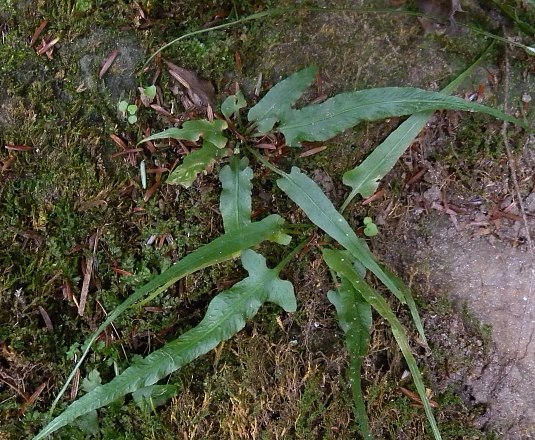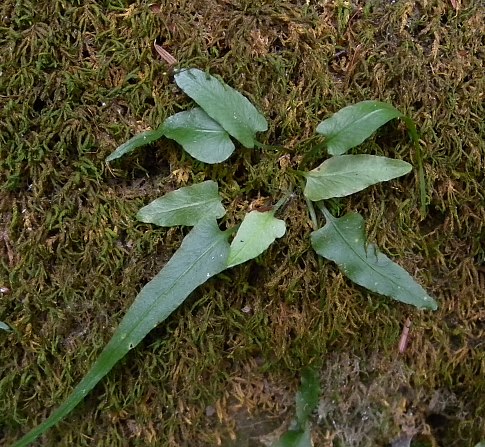Walking
Fern
Asplenium rhizophyllum
Spleenwort family (Aspleniaceae)
Description: This perennial fern consists of a small tuft of low simple leaves. The leaf blades are 2-12" long and ¼–2" across; they are lanceolate or linear-lanceolate, often with tips that are very slender and long. The base of the blade is either cordate or it may have a pair of eared basal lobes (auriculate); the margins are smooth and slightly undulate. The upper blade surface is medium to dark green and glabrous, while the lower surface is pale green; occasionally there is some sparse pubescence. The slender stipes are shorter than the blades and about ¼–4" in length. They are brown at the base, becoming green where the stipe joins the blade. Fertile and infertile leaf blades are similar in appearance, except the former is often longer than the latter. The sori (spore-bearing structures) are located on the undersides of fertile leaf blades; they are scattered irregularly across the lower surface at the vein junctures. The small sori are elongated in shape with laterally attached indusia (protective membranes). The tiny spores of the sori are released during the summer or fall and distributed by the wind. The root system consists of a short rhizomatous crown that produces the leaves and slender fibrous roots. This fern can reproduce vegetatively when the tips of the leaf blades root into the ground, developing new tufts of leaves around the mother plant. As a result, vegetative colonies of plants are often encountered.

Cultivation:
This
fern prefers light to dense shade, moist humid conditions, and thin
rocky soil. It requires a sheltered location where there is protection
from the wind.
Range & Habitat:
The native Walking Fern is widely scattered across Illinois; it is less
common in
the east-central and south-central areas of the state than elsewhere
(see Distribution
Map). Habitats include shaded ledges and crevices of cliffs
(usually limestone, less often sandstone), rocky overhangs near
streams, mossy boulders, banks of sandstone and limestone ravines, and
trunks of fallen trees (the latter habitat is less typical). This fern
is found in high quality natural areas.
Faunal Associations:
Very little is known about the floral-faunal relationships of this
fern. The aphids Amphorophora ampullata, Idiopterus
nephrelepidis, Macrosiphum adianti, and Macrosiphum
ptericolens suck juices from Asplenium spp.,
(Spleenworts), although some of these records may be based on the
misidentification
of aphid species. Because this small fern typically occurs
in habitats that are shaded and inaccessible, it is not often browsed
by vertebrate herbivores.

Photographic
Location:
A mossy rocky bank of a sandstone ravine at Turkey Run State Park in
west-central Indiana.
Comments:
This charming fern has a distinct appearance and an unusual method of
vegetative reproduction. It is easy to identify because no other fern
in the state resembles it. At one time, Walking Fern was classified in
its own genus and it was referred to as Camptosorus
rhizophyllus. Because of its ability to hybridize with
several Asplenium spp. (Spleenworts) and the
structural similarity of their respective sori, it has been assigned to
the same genus as the Spleenworts. Examples of its offspring include Asplenium
× ebenoides (Scott's Spleenwort) and Asplenium
pinnatifidum (Lobed Spleenwort). These latter ferns have
pinnatifid leaf blades with several rounded lobes along their leaf
margins. In contrast, Walking Fern produces simple leaves that either
lack lobes, or there is at most a single pair of small rounded lobes at
the base of the blade.